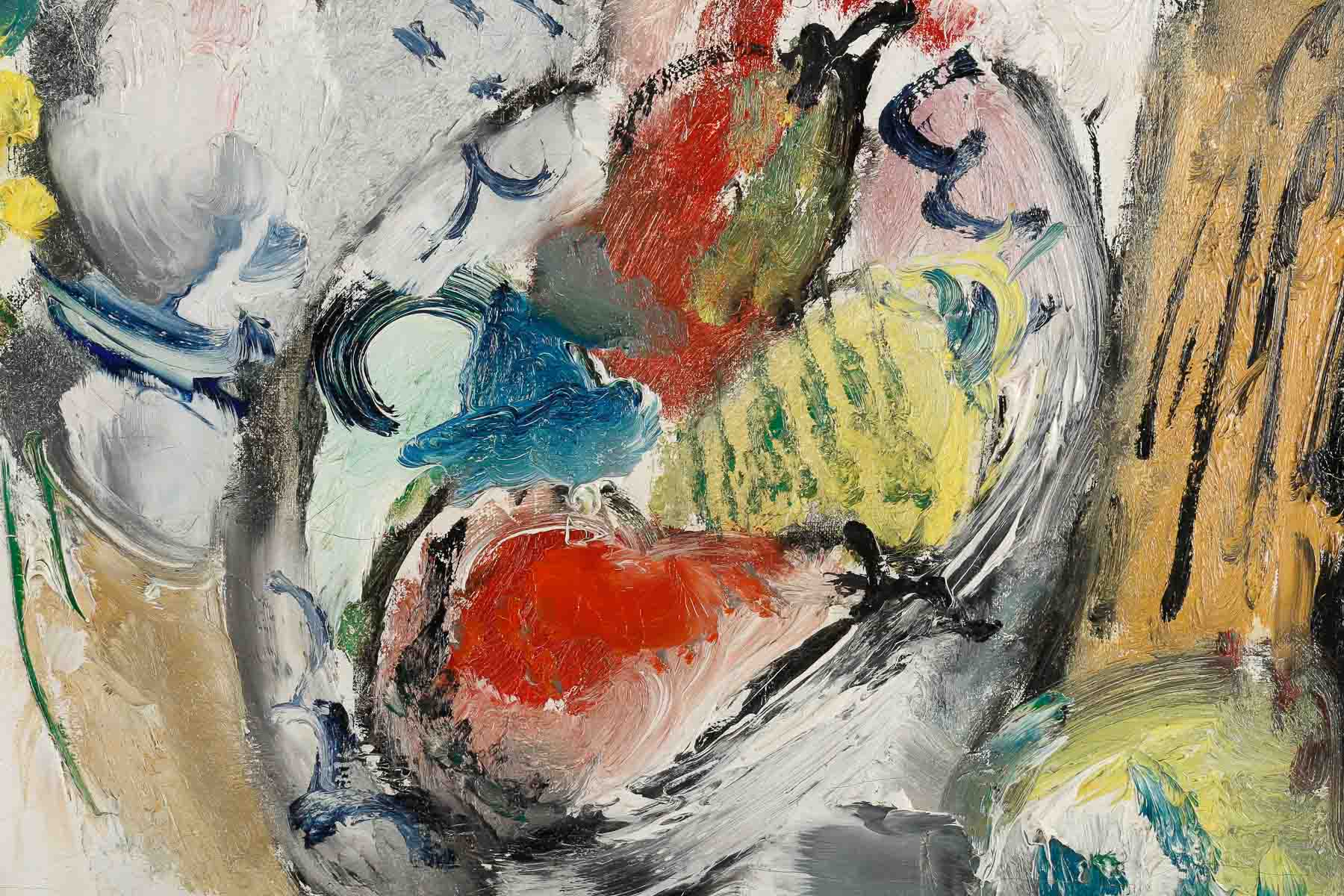Eugène Gen Paul
Still life with fruit bowl and bouquet of flowers by Gen Paul, 1927. An expressionist, cheerful work in shimmering colors.
Oil on canvas
Signed upper right
dated 1927 on the back of the frame
Dimensions: 81.5 x 65 cm
With frame: 104 x 88 cm
Price upon request.
The fiery years of 1925-1930, Gen Paul’s best years.
Between abstraction and figuration, in the 20s Gen Paul painted above all what he loved. it’s full of joy, and our painting is testimony to that.
Gen Paul, eager for life and movement, snatches up a bowl of fruit and a colorful bouquet, which he then throws wildly onto his canvas in a joyful, orderly disorder.
Gen Paul one of the masters of French Expressionism,
Gen Paul depicts a still life with a bowl of fruit and a bouquet of flowers. He uses extraordinary technical virtuosity.The vase and bowl are delicately marked with a few brushstrokes; the beauty of the art of suggestion, they take on shape and consistency. White occupies an important place. Spots of bright color splash against it. The painter completes his fireworks display with a few black brushstrokes. An economy of means that denotes his artistic talent.
Biography
He began painting at an early age. His apprenticeship was an original one: as an apprentice interior decorator, he looked around him in wealthy apartments.Passionate about painting and eager for knowledge, he observed the works collected by art lovers wherever his work took him. He also familiarized himself with human anatomy by getting to know surgeons and accompanying them into surgery rooms. He completed his training during the few years he spent at the École des Beaux-Arts in Paris.
In 1913, he volunteered for the front and was wounded. A year later, a second injury led to the amputation of his right leg. Returning to Paris in 1916, he began to paint. His first oil painting – The Moulin de la Galette seen from his window – dates from 1916. From then on, Eugène Paul began his career as a painter. He painted numerous views of Paris to satisfy demand.He signed his first canvas “GEN-PAUL” in 1918. In 1920, he exhibited at the Salon d’Automne, and remained faithful to this institution, as well as to the Salon des Indépendants. He travels to Spain and confronts the masterpieces of the masters: Goya, El Greco, Velasquez… On his return, he makes even greater use of black in his compositions.
His first solo exhibition took place at Galerie Bing in 1926. He illustrates several of Céline’s books, including Voyage au bout de la nuit and Mort au crédit in 1942. He also produced engravings, some of which were published in a collection entitled Vues de Montmartre.At the end of the Second World War, he made frequent trips to the United States and New York. At the time, he held the rank of general. In 1952, the Drouant-David gallery in Paris held a retrospective of his work.Apart from the annual events of the Paris art scene (the Salons), Gen Paul exhibited only exceptionally. Unaffected by success and fame, he never took a painting to a dealer. He refused to depend on any gallery. At the end of his life, he traveled frequently in France and Spain.
Bibliography
– Francis Carco, Gen Paul, Éditions de la Galerie Drouant-David, 1952.
– André Chamson, Collection Girardin, Éditions du Petit Palais, Paris, 1954.
– Raymond Nacenta, The School of Paris – The painters and the artistic climate of Paris since 1910, Osbourne Press, London, 1960.
– François Gibault, Céline, cavalier de l’apocalypse (1944-1961), Mercure de France, 1961.
– Jean-Paul Crespelle, Montmartre vivant, Hachette, 1964. See chapter 8 (pp. 224-247): “Gen Paul, de la rue Lepic”.
– Les Muses – Encyclopédie des arts, Éditions Grange Balelière, 1972.
– Pierre Davaine (preface by Jean Miller), Gen Paul, Éditions I.G.E., 1974.
– Emmanuel David (interviews with Herve Le Boterf), Le métier de marchand de tableaux, Éditions France-Empire, 1978.
– Carlo a Marca (preface by Marc-Édouard Nabe), Gen Paul, Transédition, 1986.
– Gabrielle Aber-Gen Paul, Guy Vignoht (“The Force of Instinct of an Expressionist Giant”),
– Jeanine Warnod, Gen Paul, 1895-1975, exhibition catalog, Palais des Beaux-Arts, Menton, 1993.
– Chantal Le Bobinnec, Gen Paul à Montmartre, Éditions Chalmin et Perrin, 1995.
– André Roussard and Carlo a Marca, Catalogue of the Gen Paul exhibition, Couvent des Cordeliers, 1995.
– Gérald Schurr, Le Guidargus de la peinture, Les Éditions de l’Amateur, 1996.
– Carlo a Marca, Joann a Marca, Gabrielle Aber-Gen Paul , Gen Paul (1895-1975), published by Hotel Splügenschloss, Zurich, 1998.
– André Roussard, Gen Paul. La biographie, Éditions André Roussard, 2006, 304 p. [présentation en ligne [archive]].
– Jacques Lambert (preface by Claude Duneton), Gen Paul: Un peintre maudit parmi les siens, La Table Ronde, 2007
– Chantal Le Boubinnec (presentation by Claude Duneton), Gen Paul à Montmartre, Les éditions de Paris – Max Chaleil, 2007
– Francesco Rapazzini, Le Moulin Rouge en folies – Quand le cabaret le plus célèbre du monde inspire les artistes, Le Cherche Midi, 2016.
– Marie-France Coquard, “Gen Paul et Jean-Pierre Serrier, deux potes de Montmartre,” Revue Paris Montmartre.
Museums
– Posthumous group exhibitions include:
• Roussard Gallery, Paris (1999)
• Roussard Gallery, Paris (2002)
. In Paris:
– Musée d’Art Moderne de la Ville de Paris
– Carnavalet Museum
– Musée d’ Orsay
– Petit Palais, Paris
– National Museum of Modern Art
– Center Pompidou
– Bourdelle Museum
– Center national des arts plastiques
. Outside Paris :
– Museum Toulouse, Les Abattoirs.
– Granville Musée d’Art moderne Richard-Anacréon,
– Honfleur, Eugène-Boudin Museum Honfleur.
– Menton, Museum of Fine Arts
-Dunkerque, Lieu d’art et action contemporaine,
. Abroad
– Bern, Museum of Fine Arts .
– Geneva, Petit Palais.









